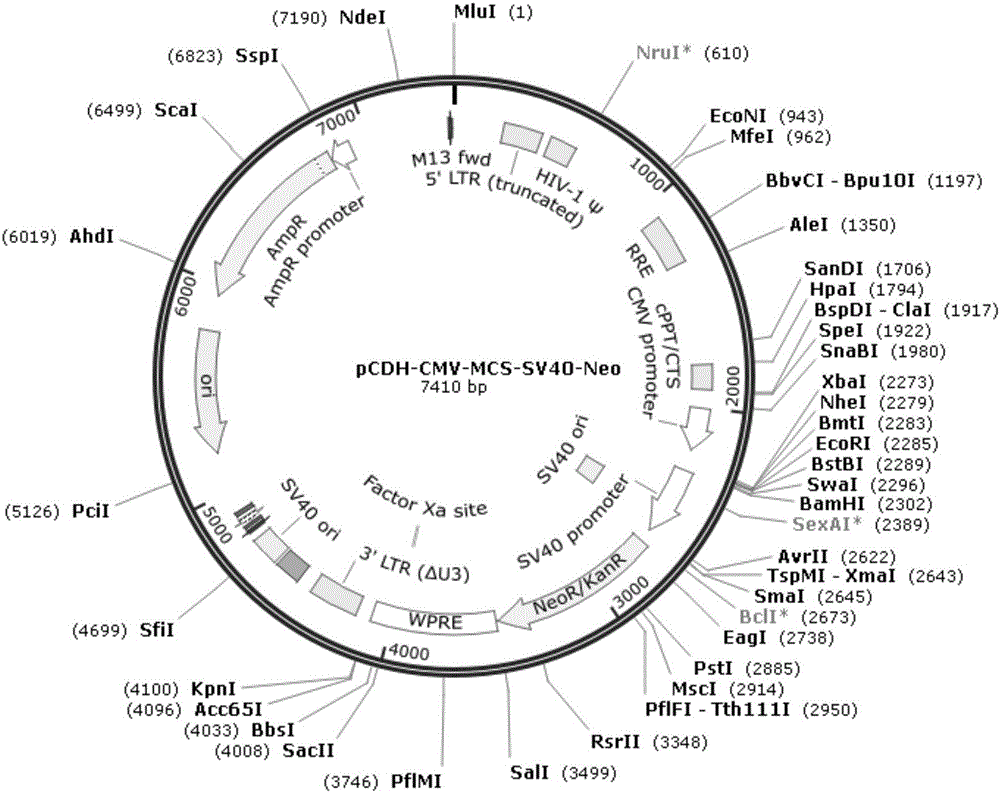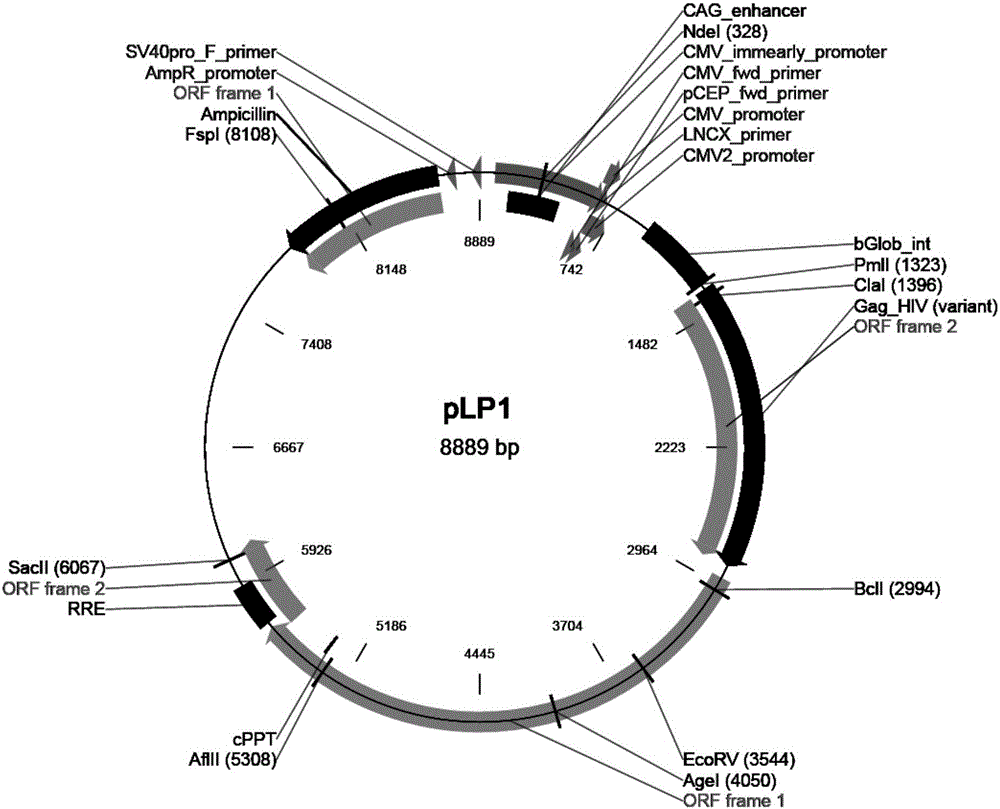Lentiviral vector efficiently mediating overexpression of T1R2 gene and lentivirus, and construction methods thereof
A technology of gene overexpression and lentiviral vector, applied in the field of molecular biology, can solve the problems of low success rate of cell lines, low transfection efficiency of liposome transfection plasmid vector, etc., and achieve the effect of promoting stable expression
- Summary
- Abstract
- Description
- Claims
- Application Information
AI Technical Summary
Problems solved by technology
Method used
Image
Examples
Embodiment 1
[0044] Example 1: Construction of T1R2 gene overexpression lentiviral vector.
[0045] 1. Artificially synthesized T1R2 gene, the DNA sequence of which is shown in SEQ ID NO.1.
[0046] 2. Using PrimeSTAR high-fidelity enzyme, using the artificially synthesized T1R2 gene as a template, perform PCR amplification with the primers shown in Table 1:
[0047] Table 1
[0048]
[0049]
[0050] The PCR reaction system and conditions are shown in Table 2:
[0051] Table 2
[0052] Reagent
volume
template
1μL
Upstream primer (10μM)
1μL
Downstream primer (10μM)
1μL
Prime STAR Max (2x)
10 μL
wxya 2 o
7μL
total capacity
20 μL
[0053] The PCR program is shown in Table 3:
[0054] table 3
[0055]
[0056] 3. Agarose gel electrophoresis to detect whether the size of the PCR amplification product is consistent with the expectation, cut the target fragment band in the agarose gel electrophore...
Embodiment 2
[0072] Example 2: Packaging of T1R2 lentivirus
[0073] 1. Replace the HEK293 cells with a confluence of more than 80% with antibiotic-free medium DMEM+10% (v / v) FBS, 37°C, 5% (v / v) CO 2 Incubator for 2 hours.
[0074] 2. Mix the packaging plasmid mixture (pLP / VSVG+pLP1+pLP2, 3 μg each) and 4 μg T1R2 gene overexpression lentiviral vector in 400 μL 0.9% (w / v) saline, and add 50 μL transfection reagent Fitran, room temperature After standing and incubating for 20 minutes, slowly and evenly drop it into the culture dish containing HEK293 cells in step 1, and shake it properly; record it as the start time of transfection.
[0075] 3. After 4-6 hours of transfection, prepare to change the medium. After discarding the old medium, absorb an appropriate amount of PBS to gently rinse the cells for 1-2 times, and replace with DMEM medium containing 2% (v / v) FBS.
[0076] 4. Collect the supernatant 72 hours after transfection, centrifuge the collected supernatant at 3000rpm at 4°C for ...
Embodiment 3
[0079] Example 3: Cell Transfection
[0080] 1. Cultivate HEK293 cells in a 6-well cell culture plate. After the cells are completely adherent and confluent to 40%-50%, the cells can be transfected; before transfection, replace the cells in each well with 500 μL of fresh DMEM for complete culture Base, and 1 μL of polybrene (polybrene) was added to each well, and placed in an incubator for 1 h.
[0081] 2. Add 5 μL of the T1R2 lentivirus solution obtained in Example 2 to the two wells of the above-mentioned 6-well cell culture plate, and add 10 μL of the empty lentivirus solution to the cells in one well (the empty lentivirus solution and the T1R2 lentivirus solution The only difference is that it does not contain the T1R2 gene, and the rest of the preparation methods are the same), and the other well is used as a blank cell control. 2 , 95% relative humidity incubator.
[0082] 3. After 6 hours of transfection, suck away the medium in the well, and wash it twice with PBS; r...
PUM
 Login to View More
Login to View More Abstract
Description
Claims
Application Information
 Login to View More
Login to View More - Generate Ideas
- Intellectual Property
- Life Sciences
- Materials
- Tech Scout
- Unparalleled Data Quality
- Higher Quality Content
- 60% Fewer Hallucinations
Browse by: Latest US Patents, China's latest patents, Technical Efficacy Thesaurus, Application Domain, Technology Topic, Popular Technical Reports.
© 2025 PatSnap. All rights reserved.Legal|Privacy policy|Modern Slavery Act Transparency Statement|Sitemap|About US| Contact US: help@patsnap.com



